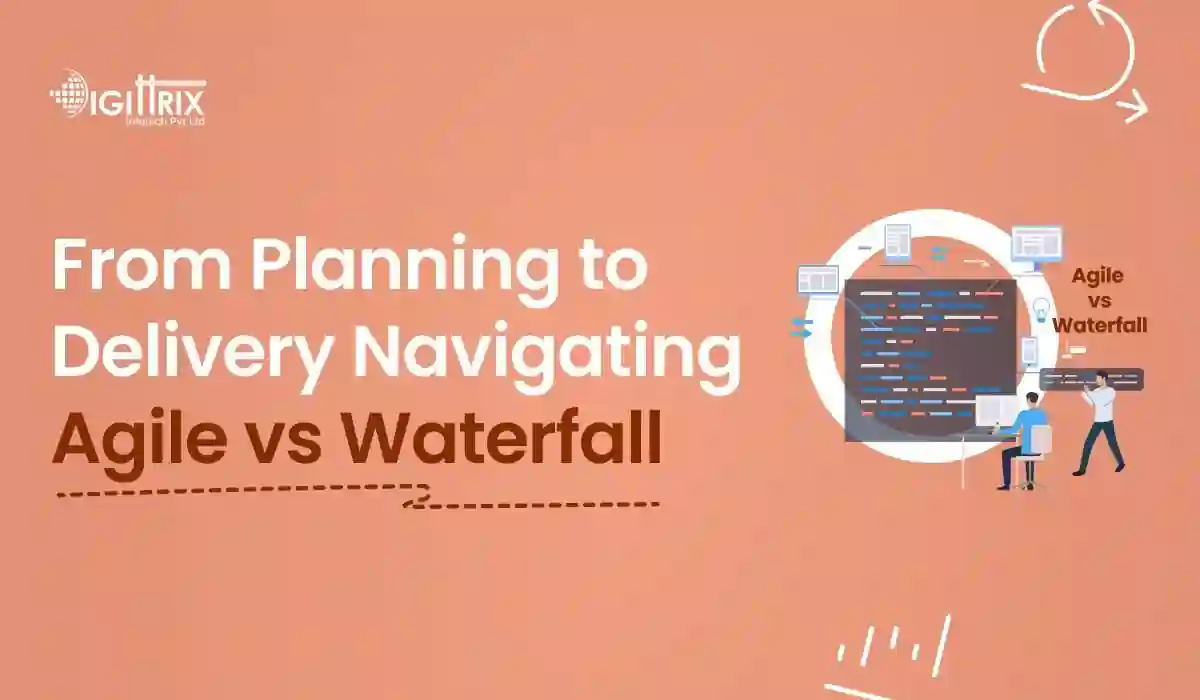Agile and Waterfall are popular software development methods. Choosing the right model depends on project size, goals, flexibility, timelines and customer involvement.
Highlights
An enthusiastic developer and skilled business management expert with over a decade of experience in the field

Software development has many moving parts, and choosing the right development methodology is one of the most important decisions a business can make. For decades, two main approaches have stood out: Agile and Waterfall. Each method has its strengths and limitations. The best choice depends on project goals, budget, timeframe, flexibility requirements, and communication structure.
This article takes a closer look at both methodologies. It compares how they work, when to use them, and which might be better in different situations. Businesses seeking custom software solutions often struggle with this decision. Understanding both approaches can help make the choice simpler.
Thinking about custom software? Find out why tailored solutions can boost efficiency and growth for your business.
Waterfall is one of the oldest methods in software development. It follows a step-by-step process. Each stage is completed before the next one begins.
This model is known for its predictability. Once the scope and requirements are defined, the development proceeds without major changes. It is often used in industries like construction, manufacturing, or government-related software, where fixed processes and documentation are important. VersionOne data shows only 11% of Waterfall projects finish on time and budget.
Agile was created as a response to the limitations of traditional approaches like Waterfall. It divides the project into small parts called “sprints.” Each sprint delivers a working part of the software. Agile encourages ongoing communication between developers and clients, and feedback is applied at each step.
Agile methods include Scrum, Kanban, and Extreme Programming (XP). These frameworks vary, but they share the same basic principles: flexibility, constant feedback, and short delivery cycles. Zippia's report says 71% of companies use Agile over Waterfall for their project success.
PMI states Agile projects are 28% more successful compared to traditional Waterfall projects.
Agile: Works in small, iterative cycles called sprints.
Waterfall: Follows a step-by-step process from start to finish.
Agile: The Client stays involved throughout the project.
Waterfall: Client is mainly involved at the beginning (during requirement gathering).
Agile: Adapts well to new changes or feedback mid-project.
Waterfall: Difficult and expensive to make changes once development starts.
Agile: The Product is delivered in parts after each sprint.
Waterfall: The Full product is delivered only at the end of the project.
Agile: Costs can change depending on project updates and scope changes.
Waterfall: Cost is fixed based on the initial plan.
Agile: Minimal documentation—only what is necessary.
Waterfall: Heavy documentation for every phase.
Agile: Testing is done during every sprint.
Waterfall: Testing is done after the development phase is complete.
Agile: Useful for evolving projects like apps, startups, or dynamic user-focused software.
Waterfall: Best for fixed-scope projects like enterprise systems, regulated industries, or government platforms.
There’s no one-size-fits-all method. The decision depends on the project's size, type, goals, and the people involved.
When choosing a software development company, understanding their development approach is crucial. Whether they follow Agile or Waterfall can impact how well they match your business style and expectations.
Companies offering software development services often use Agile when clients need to adjust features during development. It works well for businesses that expect feedback from users or markets during the product's early stages. On the other hand, Waterfall is better when clients want a finished product delivered based on clearly written requirements.
If your business needs a solution that is built from scratch, involving unique workflows or specialized user roles, then custom software development is the way to go. And that makes it even more important to pick the right development method.
Some businesses combine both methods. The hybrid approach starts with a Waterfall-like planning phase to define goals and scope. Then it shifts to Agile for development and delivery. This can give the structure of a Waterfall with the flexibility of Agile.
For example, a custom software development company may define initial goals and modules using Waterfall but deliver them through Agile sprints. This gives clients a better overview while still allowing feedback and changes.
Before deciding on Agile or Waterfall, consider the following:
The question "Which software development method is best?" doesn’t have one single answer. Both Agile and Waterfall have their place in the world of software development.
Agile is flexible and better for situations where quick changes are needed. Waterfall is structured and works well for fixed requirements. Businesses looking for custom software development should first analyze their needs and then discuss them with the development team.
In the end, choosing the right method depends on what you want to build, how much time and money you can invest, and how involved you want to be during the development process.
Whichever path you choose, having a good understanding of Agile and Waterfall will help you work more confidently with your custom software development company and get the most out of your software development services.
When it comes to building custom software, selecting the right development method can make a big difference. At Digittrix, we help businesses choose between Agile and Waterfall models based on their specific project needs and goals. Each method offers unique advantages, and understanding which one suits your software project best is key to successful development.
Whether your project needs the flexibility of Agile or the structured planning of Waterfall, our team provides the right software development services to match. From custom software development to long-term software development solutions, we guide you through the entire process.
With 14 years of experience, Digittrix has supported various industries with both Agile and Waterfall practices. If you're not sure which model fits your needs, our experts will help you decide by analyzing your timeline, budget, project type, and more.
Need help with a custom software project? Talk to our technical managers for guidance on choosing the best approach. Call us at +91 8727000867 or email digittrix@gmail.com to schedule your consultation today.

Do you need help in Mobile App development?




Join over 1500+ businesses we've already helped!
Agile works in short, repeatable cycles with frequent updates, while Waterfall follows a fixed, step-by-step approach from start to finish.
It depends on your project. Agile is better for flexible, evolving projects, while Waterfall suits projects with fixed requirements and deadlines.
Agile works best for fast-moving or customer-focused projects. It may not be ideal for projects that require strict rules and fixed documentation.
Agile can lead to changing costs depending on ongoing updates. A waterfall often has a fixed cost based on early planning.

©2025Digittrix Infotech Private Limited , All rights reserved.